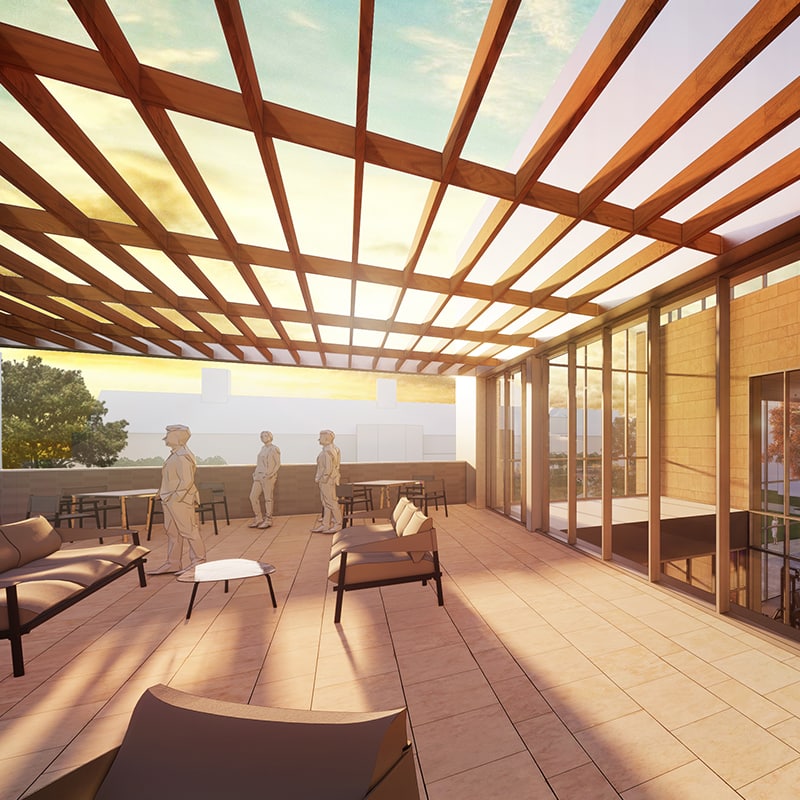Solar Analysis Sheds Light on Efficient Energy Use

Tuesday, September 14, 2021
One of the most powerful tools our architects use early in the design process is solar analysis software, which analyzes how sunlight and sun patterns will impact various aspects of a project. Project Designer Will Schenck comments, “solar analysis is a vital step in the early stages of our design process. Understanding building orientation, energy impact, daylighting, shadows, and glare allow us to maximize the potential of any space.” In addition to providing great insight to the project team early in the design process, solar analysis is most useful to our architects and designers to:
- Study natural light in interior spaces,
- Design building exteriors more efficiently, and
- Reduce energy consumption in buildings.
Solar analysis is very helpful in studying natural light in interior spaces. Programs like Revit allow our design teams to see what areas in a building are well-lit during the day and which need lighting from alternative sources. Redesigning buildings to better channel natural light results in more efficient energy use and cost savings for years to come. Programmable interior lighting can be programmed to turn on or off when there is sufficient natural light filling a room, thus using less energy during the day. Solar analysis can also help interior designers select appropriate finishes for walls and furniture, as some materials can cause glare or capture hear during the day. Also, solar analysis is helpful in creating accurate renderings of how interior spaces will look at different times throughout the day, using heat mats to identify areas vulnerable to getting hot or cold, and even determining how vegetation and greenery can change temperatures and lighting. Thanks to solar analysis, our architects are able to better tailor a building to the needs of a client and prevent temperature variation issues from the start.
Solar analysis can also help inform energy-efficient exterior design. Shadow studies analyze how the presence of a building will impact the surrounding environment, which includes neighboring buildings as well as natural surroundings like forests, wetlands, and prairies, and the organisms that live there. The shadows cast by a new building or addition can significantly change the ambiance of its surroundings, for better or worse. This is particularly true when working on a university or corporate campus, as these are places where buildings are close together and changes to one building may interrupt a previously beautiful area. Shadow studies are also particularly important in landscape architecture, as they help inform where to place certain plants so as to have enough sunlight and water available to thrive in relation to a project. Additionally, such studies can help determine if and where trees are needed to mitigate heat from different sides of a building. This in-depth level of modeling allows our architects and designers to give a client a better feel for what their completed project will look like and how it will relate to surrounding buildings and natural features.
Finally, solar analysis is also used to help clients reduce energy consumption in their buildings. Design choices may include the placement of windows to maximize natural light, or it may involve a bigger change such as the orientation of the building. Considering building orientation on a site can completely change the lighting atmosphere in a building as well as impact its energy efficiency. This type of analysis is also very important when it comes to photovoltaic or solar power installations on buildings. Solar analysis software is capable of calculating how many hours a day sunlight hits a certain part of a structure and much power that installation will generate over time. Having these numbers close at hand through the architectural design process helps our designers guide a client to make good choices regarding energy usage and also allows them to better understand cost savings in the long run.
Ultimately, solar analysis helps our team better tailor our architectural design services to the specialized needs and goals of each client. The data gathered from this analysis empowers architects and client teams to make informed decisions regarding the lighting of their building, its temperature throughout the day, and even how they want guests to feel when they enter the building. Solar analysis is an invaluable tool in modern architectural design, allowing clients to see how the warm afternoon sun will make a hallway of skylights look in their space before designs have even left the digital drawing board.
To learn more about solar analysis can benefit the architectural design process of your next project, contact Will Schenck at [email protected] or (314) 863-5717.